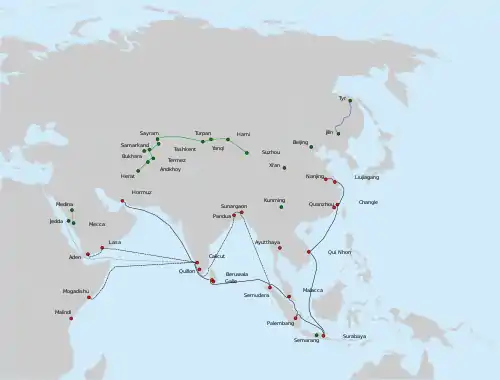
Chen Cheng (陈诚; 陳誠; Chén Chéng; Ch'en Ch'eng) (1365–1457), courtesy name Zilu (子鲁), pseudonym Zhushan (竹山), was a Chinese diplomat known for his overland journeys into Central Asia during the Ming dynasty. His travels were contemporaneous to the treasure voyages of the admiral Zheng He.
Life
Chen was born in 1365 in Linchuan County, Jiangxi province. He obtained the positions of juren (举人) and jinshi (進士) in 1393 and 1394 respectively after taking the imperial examination.[1][2][3]
In 1396, Chen was sent on a diplomatic mission to the western region of Qaidam to establish border defence. In 1397, he was sent by the Hongwu Emperor as an envoy to Vietnam. From 1406 to 1411, he served in the Wenyuange (文渊阁), the imperial library in the Forbidden City, as an editor of the Yongle Encyclopedia.
Buddhist idols and temples in Turfan were described in 1414 by Chen Cheng.[4][5]
In 1414, 1416 and 1420, Chen Cheng led a Ming mission to the court of the Timurid dynasty at Samarkand.[6]
Works by Chen Cheng
- Travel in the Western Region
- Xi yu fan guo zhi, "A Record of the Barbarian Countries in the Western Region."
See also
- Ghiyāth al-dīn Naqqāsh, the diarist of Shahrukh's embassy to the Yongle Emperor's court (1420–1422).
- Ruy Gonzáles de Clavijo, another diplomat – from Spain – who visited Samarkand a few years before Chen Cheng.
- Hanlin Academy § Bureau of Translators
Notes
- ↑ Morris Rossabi (28 November 2014). From Yuan to Modern China and Mongolia: The Writings of Morris Rossabi. BRILL. pp. 125–. ISBN 978-90-04-28529-3.
- ↑ Rossabi, Morris (1976). "Two Ming Envoys to Inner Asia". T'oung Pao. 62 (1/3): 1–34. doi:10.1163/156853276X00016. JSTOR 4528048.
- ↑ Hecker, Felicia J. (1993). "A Fifteenth-Century Chinese Diplomat in Herat". Journal of the Royal Asiatic Society. 3 (1): 85–98. doi:10.1017/S1356186300003692. JSTOR 25182641. S2CID 153758529.
- ↑ ROSSABI, M. (1972). "Ming China and Turfan, 1406-1517". Central Asiatic Journal. 16 (3): 206–225. JSTOR 41926952.
- ↑ Morris Rossabi (28 November 2014). From Yuan to Modern China and Mongolia: The Writings of Morris Rossabi. BRILL. pp. 45–. ISBN 978-90-04-28529-3.
- ↑ Tsai 2002, p. 162.
References
- F. J. Hecker, A fifteenth-century Chinese diplomat in Herat, Journal of the Royal Asiatic Society, 3rd series p85-91, 1993.
- Hecker, Felicia J. (1993). "A Fifteenth-Century Chinese Diplomat in Herat". Journal of the Royal Asiatic Society. 3 (1): 85–98. doi:10.1017/S1356186300003692. JSTOR 25182641. S2CID 153758529.
- Tsai, Shih-Shan Henry (2002), Perpetual Happiness: The Ming Emperor Yongle, University of Washington Press, ISBN 0-295-98124-5
- Goodrich, L. Carrington; Tay, C.N. (1976), "Ch'en Ch'eng", in Goodrich, L. Carrington; Fang, Chaoying (eds.), Dictionary of Ming Biography, 1368–1644. Volume I (A-L), Columbia University Press, pp. 144–145, ISBN 0-231-03801-1
- Rossabi, Morris (1976). "Two Ming Envoys to Inner Asia". T'oung Pao. 62 (1/3): 1–34. doi:10.1163/156853276X00016. JSTOR 4528048.